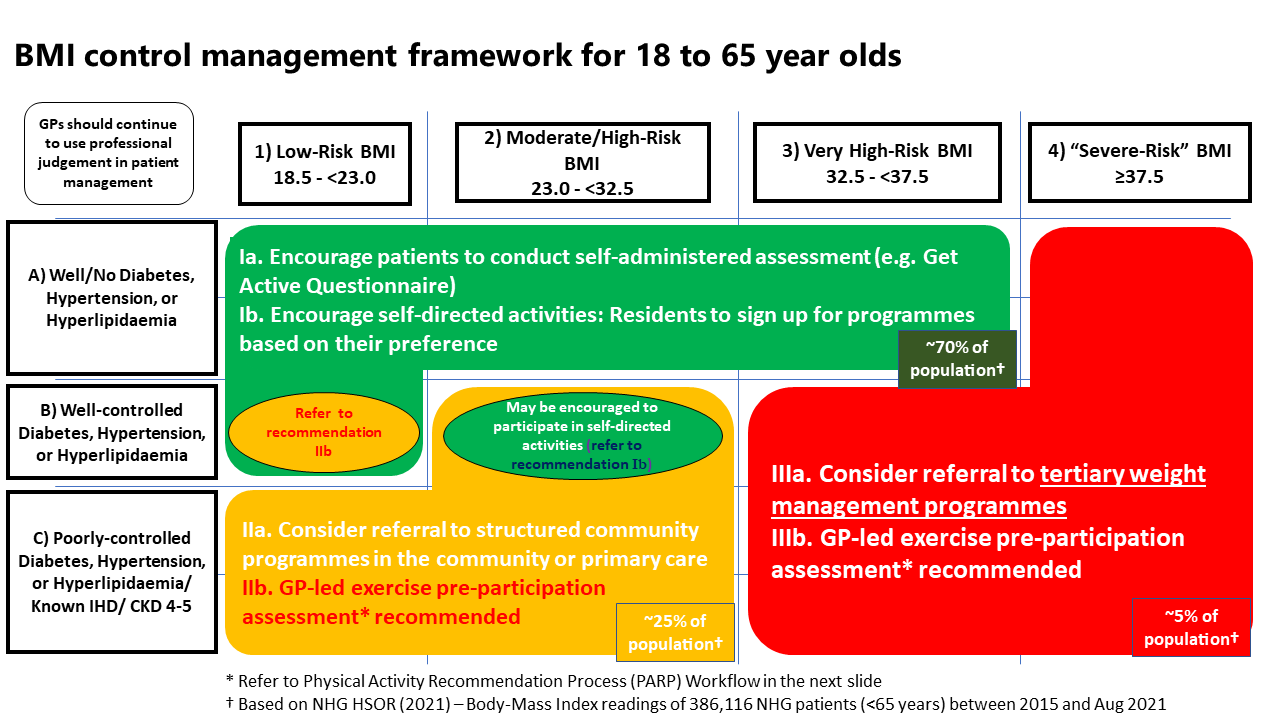Both a healthy diet and physical activity are essential to controlling BMI.
Diet
In enrollees with no chronic conditions, GPs may advise them to use My Healthy Plate.
Aim to start by substituting ≥20% of refined carbohydrates with wholegrains, and choose lean protein, fresh produce, and healthier oils and fats.
Reduce salt and sugar intake, and increase soluble fibre consumption.
Older adults should include protein as part of every meal.
For further guidance on nutrition and healthy eating, please refer to the Lifestyle Prescriptions document.
Figure 1 below provides a framework to guide GPs on the management approach and programmes that can be recommended to patients aged 18 to 65 years old, depending on their profile. (Some programmes may address diet as well.)
For patients above 65 years old, GPs may examine the history of weight change over their patient's lifetime to gain a more complete understanding of their risk profiles3 (e.g. recent, unintentional weight loss may require further investigation). For patients with high BMI, identify if they have conditions and/or risk factors that would make weight loss desirable (e.g. DM, osteoarthritis). For patients with low BMI or who are pre-frail/frail, muscle strengthening activities and multi-component physical activity that emphasises strength and functional balance should be recommended4 to reduce sarcopenia as well as risk of falls and fractures.
Figure 1: BMI control management framework for 18 to 65 year olds.
 Physical Activity Recommendation Process (PARP) Workflow
Physical Activity Recommendation Process (PARP) Workflow
Full list of subsidised weight management programmes offered under Healthier SG: Green Segment, Orange Segment, Red Segment.
“Green" segment
As patients in this group do not have significant risk factors, you may encourage them to sign up for programmes via
HPB's Healthy 365 (H365) application , including those from the Health Promotion Board (HPB), SportSG, and People's Association (PA). Click here for the list of available "green" segment programmes. Self-administered assessment may be performed with the recommended tools such as the Physical Activity Readiness Questionnaire (PAR-Q) or the Get Active Questionnaire (GAQ).
Indicators of physical activity (e.g. step count, moderate to vigorous physical activity [MVPA] minutes), patient's diet logging, and participation in national programmes administered by HPB, will be captured on the patient's H365 app.
“Orange" segment
As patients in this group have risk factors that may predispose them to cardiovascular events during physical activity, exercise pre-participation assessment by their enrolled doctor is recommended. Refer to the Physical Activity Recommendation Process (PARP) workflow.
Given the need for patient education on exercise, diet, and other lifestyle changes for chronic disease management, GPs may consider referring their patients to structured weight management programmes. Patients with
well-controlled chronic diseases can be referred to Active Health Targeted Programmes managed by SportSG and run by accredited Exercise is Medicine trained coaches. Click here for the list of available "orange" segment programmes. GPs are encouraged to complete a referral form. Patients should book and attend the recommended programmes so that the Active Health Coach can tailor and directly proceed with the exercise recommendation with them. More details on SportSG’s referral workflow are available here .
For patients with
poorly-controlled chronic diseases, the focus of treatment should be the proper management of their chronic diseases. GPs should work with other members of their care teams to achieve this. GPs may wish to contact their PCN HQs for support from care teams who can counsel patients on diet, exercise and other lifestyle modifications which can contribute to both improved chronic disease management and weight management. Patients with poorly controlled chronic diseases should also be monitored more closely by the care team to ensure the safety and adherence to the management regime. Where clinically relevant and beyond the capabilities of the PCN, GPs and/or their PCN teams may seek support for their patients from other available sources (e.g. community/primary care resources, cluster support) for the management of poorly controlled chronic conditions or weight-related issues.
“Red" segment
As patients in this group have significant risk factors that predispose them to cardiovascular events during physical activity, an exercise pre-participation assessment by a doctor is recommended. Refer to the Physical Activity Recommendation Process (PARP)
workflow.
Given the need for patients to be educated and supported on the interactions between exercise and change in diet on underlying chronic diseases, GPs may consider referring patients to specialists or to tertiary-based weight management programmes. In general, listed weight management programmes for the “red” segment will accept patients who meet the following criteria:
-
Age:
BMI/health status:
Details on the “red" segment programmes can be found here. Some programmes may also accept patients outside of the stated criteria (e.g., those with BMI ≤32.5, or over the age of 65).
Once patients transit out of tertiary-based weight management programmes, GPs should consider referring them to community based structured weight management programmes and/or lifestyle counselling. De-escalation of programmes should be carried out in tandem with patients' progress in their weight change and chronic conditions they may have.
Medication1
Medications should not be prescribed for cosmetic reasons and should be used as an adjunct to lifestyle modification. Consider referring to a specialist for shared care if medications are indicated. Medications licensed for obesity in Singapore include Phentermine, Orlistat, Liraglutide, and Contrave.
Indications for prescribing medications for obesity:
- BMI ≥30 kg/m2 with or without obesity-related complications or risk factors, OR
- When BMI is 27.5 – 29.9 kg/m2 among Asians with co-morbidities or complications of obesity such as hypertension, or DM.
Surgery1
Indications for offering bariatric surgery:
Clinically severe obesity
- For Asians, BMI ≥37.5 kg/m2 OR BMI ≥32.5 kg/m2 with conditions like Type 2 DM, hypertension, lipid disorder, fatty liver, polycystic ovarian syndrome, obstructive sleep apnoea, and metabolic syndrome.
Consider referring to specialists or to tertiary-based obesity/weight management programmes if surgery is considered. Depending on the procedure, the mean weight loss after 10 years ranged from 14 to 25%.5

